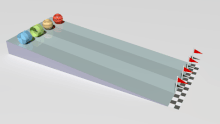Good day! In this journal I will be talking about moment of inertia and rotational motion.
WHAT I KNOW
Seriously talking, upon hearing moment of inertia the first thing that came to my mind is Newton’s Law that is a property of matter that causes it to resist changes in velocity. According to Newton’s first law of motion, an object with a given velocity maintains that velocity unless acted on by an external force. Simple
WHAT I LEARNED
Moment of Inertia
Moment of Inertia is nothing but a quantity expressing a body’s tendency to resist angular acceleration, which is the sum of the products of the mass of each particle in the body with the square of its distance from the axis of rotation. Additionally, Angular Acceleration means Angular Acceleration, also called Rotational Acceleration, it’s a quantitative expression of the change in Angular Velocity that a spinning object undergoes per unit time. It is a vector quantity, consisting of a magnitude component and either of two defined directions or senses.


For example, a body when it starts rotating it will keep doing so until we try to to stop it by a force(torque). It’s like if we have a football and a solid sphere which are both rotating with the time frequency, one will stop by applying more torque while the other will stop easily. The one stopping easily has higher moment of inertia. It is the equivalent of mass in rotational motion . There we need more force to stop a body with higher mass.

Four objects with identical masses and radii racing down a plane while rolling without slipping.
From back to front:
- spherical shell (red),
- solid sphere (yellow),
- cylindrical ring (green), and
- solid cylinder (red)).
The time for each object to reach the finishing line depends on their moment of inertia.
Note: Sphere always win and Hollow objects always lose!
Analogs for Rotational Motion
The Torque Construct: The Rotational Analog to Force
Consider a force F exerted tangentially on the rim of a wheel or disk. The rim is at a distance r from the axis of rotation. We can formally define torque, represented by the Greek letter ττ , in terms of the force F and the distance r:
where r is sometimes referred to as the moment arm of this applied force—the further away from the axis a particular force is applied, the more torque is exerted, producing more change in rotational motion. Torque can be thought of as the “turning effectiveness of a force” or “rotational force.”

This force can be broken down into its tangential and radial components, FtangentialFtangential and FradialFradial. Note that the radial component FradialFradial of this force has no effect on the rotational motion of this disk. So, for any general force exerted a distance r from a rotation axis, it is only the tangential component of this force (Ftangential)(Ftangential) that will affect rotational motion. The tangential component of the force can always be found with the appropriate trig function. If θθ is the angle between the applied force, F, and r, the tangential component is FsinθFsinθ .

Torque, along with other angular variables, has vector properties. If we imagine the torque causing the object to rotate about an axis perpendicular to the plane defined by the force and the moment arm, rr , we can use the same right-hand-rule introduced for finding the direction of θθ and ωω to find the direction of the torque ττ . If you curl the fingers of your right hand in the direction of rotation that the torque would cause, then your thumb points in the direction of the torque.
A marble is thrown with velocity V from point A. If no force is exerted on surface by marble at point B, find the force exerted on point A by marble. (Assume that velocity of marble is constant.)

Since no force is exerted on point B by marble;
mg=mV2/R
V2=g.R

Force exerted by marble on point A;
FA=G+F
FA=mg+mV2/R (we put V2=gR into the equation)
FA=mg+mgR/R
FA=2mg
HOW I LEARNED
Learning new things in creative ways is somehow help us students to understand more about the lesson. One way that Sir Lex did was to show us a video presentation of Walter Lewin about The concept of moment of inertia that is demonstrated by rolling a series of cylinders down an inclined plane.
Another one is the activity that Sir Lex let us experience, he let us decide and design the object that our group will use. my group decided to use a solid sphere and the other one is the tissue roll. And luckily our group won the challenge to be the fastest among other group and so with the slowest to roll.
This part is where we won in the fastest one to roll and the first one to reach the white line.

And this one is where we won the slowest one to reach the white line.
REFLECTIONS

There are many cross roads and bumps in every person’s life. There are many challenges that can make us stronger and make us understand life. In connection to moment of inertia which make an object stop because we know that inertia is objects resistance to change, I can connect this to life where us must be not a barrier in other people’s dreams or goals in life.
Let’s not be insensitive to other people, there are things we must do and not to do.
Resources
https://www.quora.com/What-is-an-explanation-in-simple-words-of-the-moment-of-inertia
https://www.thoughtco.com/moment-of-inertia-2699260
https://www.real-world-physics-problems.com/radius-of-gyration.html
https://phys.libretexts.org/LibreTexts/University_of_California_Davis/UCD%3A_Physics_7B/7%3A_Momentum_Conservation/7.5%3A_The_Rotational_Analogs_of_Force%2C_Momentum%2C_Mass_and_Impulse
http://www.physicstutorials.org/home/exams/rotational-motion-exams-and-solutions/rotational-motion-exam2-and-solutions
Google for the images
You must be logged in to post a comment.